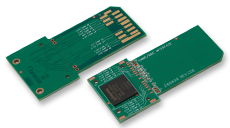Product of the Week: Kingston Technology eMMC and I-Temp eMMC
June 14, 2022
Sponsored Story

In electronics, the need for greater storage capacity and faster data transfer rates is never-ending. But now, with the explosion of mobile and IoT devices, more space and faster speeds have been joined by the requirement that flash memory and flash memory controllers consume less and less space on resource-constrained device PCBs.
Of course, systems deployed in embedded or industrial environments often need the extra dimensions of robust reliability and extended temperature support as well.
Checking off all these boxes for device manufacturers are the eMMC and I-Temp eMMC non-volatile NAND flash memories from Kingston Technology. The integrated BGA packages include both 3D TLC or MLC memories and a controller in form factors as compact as 9 x 7.5 x 0.8 mm. But despite this size reduction, they don’t skimp on capacity offering sizes that range from 4 GB all the way up to 256 GB.

Kingston’s eMMC and I-Temp eMMC in Action
Both flavors, regular eMMC and the I-Temp eMMC solutions that support -40ºC to +85 operating temperature ranges are compliant with the JEDEC 5.1 interface standard (some are also backward compatible with earlier eMMC standards).
Integration is the key advantage with Kingston’s latest eMMC offerings, as the bundled controller offloads all memory management tasks from the host processor so it can focus on other workloads. These tasks include error correction code (ECC) handling, wear-leveling to improve data write efficiency, and IOPS optimization and read sensing that help free up extra space on the storage devices.
In addition to consuming less space and offloading the host of storage control tasks, the drive controllers and JEDEC interface combine to abstract subtle differences in NAND technology from the application to help streamline software use and design ins.
Getting Started with the eMMC + I-Temp eMMC
Realizing that many embedded, IoT, and mobile applications may begin prototyping on PCBs with no eMMC footprint defined, Kingston has taken the additional step of creating an eMMC Adapter board that allows users to evaluate their eMMC technology through an SD or MMC card slot without having to change the PCB layout.
An Adapter board is available for every capacity in the product line.
For more information on the Kingston Technology eMMC and I-Temp eMMC product lines, visit their product page at www.kingston.com/en/embedded/emmc-embedded-flash to compare part numbers, capacities, footprints, NAND type, and interface compatibility, or check out the resources below.
Resources:
- Kingston Technology eMMC and eMMC I-Temp product page: www.kingston.com/en/embedded/emmc-embedded-flash
- Kingston Technology eMMC Flyer: https://media.kingston.com/pdfs/emmc/emmc_flyer_us.pdf
- Kingston Technology eMMC I-Temp Flyer: https://media.kingston.com/pdfs/emmc/itemp-emmc_flyer_us.pdf
- Kingston Technology contact form: www.kingston.com/en/form/embedded





